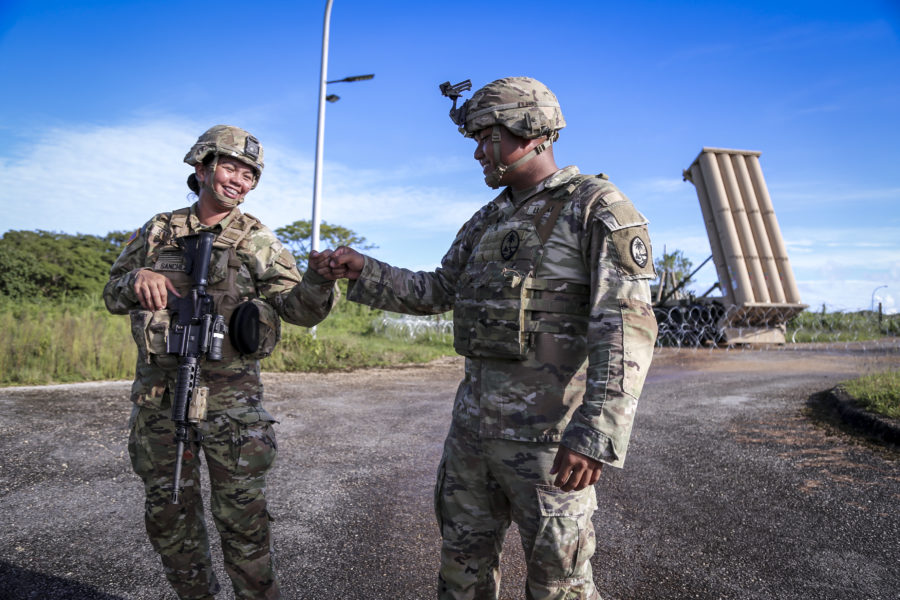The Department of Defense is getting ready to overhaul its air and missile defenses on Guam, perhaps the most critical U.S. military hub in striking distance of China. DOD plans to invest $1.5 billion in a new missile and air shield for Guam in fiscal 2024, part of a long-awaited effort to better defend the territory.
“Current forces are capable of defending Guam against today’s North Korean ballistic missile threats,” Michelle C. Atkinson, the director of operations for the Missile Defense Agency, told reporters March 13. “However, the regional threat to Guam, including those from [the People’s Republic of China] continues to rapidly evolve.”
The new systems headed for the U.S. territory will include radars, launchers, interceptors, and command and control systems to counter the increasing capabilities of the Chinese cruise and ballistic missiles and other threats.
“Guam has the perfect air and missile defense problem,” said Tom Karako, an air and missile defense expert at the Center for Strategic and International Studies. “It’s wicked hard because we have to integrate all these different defenses because the potential adversary, China, is going to have a complex and integrated attack of everything from drones to cruise missiles to ballistics to gliders, etcetera. We have to put those things together so that they can’t attack the gaps and the seams of those several systems.”
Guam, the Westernmost U.S. territory, is a critical staging location for American forces in the Pacific, providing airfields and ports for nuclear submarines, aircraft carriers, and strategic bombers, as well as jungle warfare training for the Marine Corps. The Pentagon is investing heavily now in dispersing its forces, leveraging new basing agreements with allies that will allow U.S. submarines to forward deploy to Australia, for example, and Air Force jets to drop in and operate from remote air bases throughout the western Pacific under the Air Force’s Agile Combat Employment (ACE) concept. Regardless of how many “spokes” U.S. forces operate from in the region, Guam will remain a large and critical hub.
Yet there is still a long way to go to comprehensively defend Guam against aerial threats.
“The fundamental criteria are schedule and capability,” Karako said.
The island is currently protected by the Army’s Terminal High Altitude Area Defense (THAAD) ballistic missile defense system and the Navy’s Aegis system off the coast, which will continue to be supported by the Missile Defense Agency. The MDA plans to invest $801 million for Guam’s defense in fiscal 2024.
“We’re on a very short timetable on Guam,” Vice Adm. Jon A. Hill, the director of the Missile Defense Agency said at a CSIS event March 24. “We’re doing it because of location, location, location. … It deserves to be defended.”
Most of the MDA’s money would not go directly to any one piece of kit, but toward working out an overall integrated air and missile defense architecture for the island through research, development, test, and evaluation.
“It is not simple—it is hard, hard work.” Hill said. “We’re running lots of studies right now to see which is best.”
The Army and Navy will continue to play a large role. Army plans provide Lower Tier Air and Missile Defense Sensors (LTAMDS), the high-end PATRIOT system, and Indirect Fires Protection Capability (IFPC).
“There is no end state,” Hill told reporters at the McAleese and Associates defense conference March 15. “We’re going to deliver capability as it’s ready and we’re going to continue to build it out.”
The Navy’s Aegis system already exists, and it has been placed on land before in Poland and Romania as the so-called Aegis Ashore system. But while roughly one-third of Guam is controlled by the U.S. military, the island is a tourist attraction. China may clear islands to create militarized fortresses, but the MDA must consider Guam’s difficult Pacific island terrain and its natural beauty. Therefore, the Aegis Guam System will be tailored to the island, including the integration of new AN/TPY-6 radars as part of an effort to create a 360-degree ability to see and engage all threats to the island, a much desired but often difficult prospect in the air defense world. The plan is for Aegis to work alongside the Army’s Integrated Air and Missile Defense Battle Command System (IBCS).
“It really is combined, at the simple level, Aegis and IBCS working together on the island,” Hill said March 13. “We have a mix of launchers on the island.”
All these systems will then have to have a linked command and control network to see and shoot the right targets with the right interceptor at the right time—on architecture that will be evolving.
“It’s important to get that out there as quickly as possible while we simultaneously ascertain the best way to integrate or interoperate the several command and control systems for all of these elements,” Karako said. “That last piece, the command and control, is going to be a vexing challenge.”
